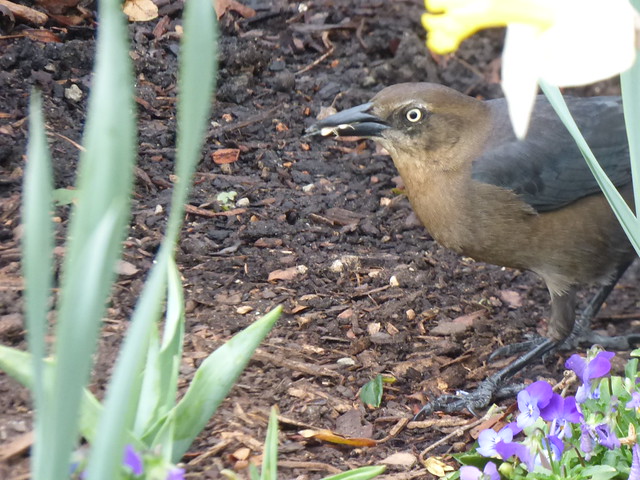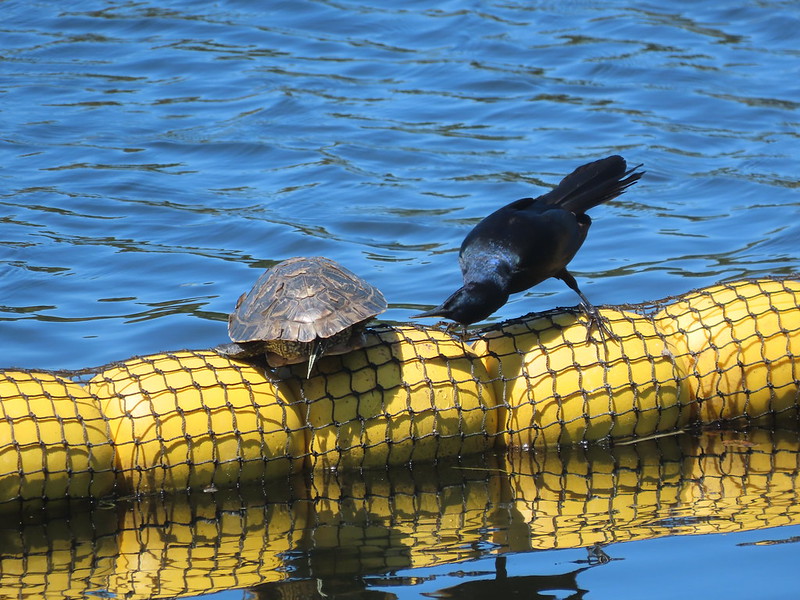Boat-Tailed Grackles are conspicuous and clever Florida birds that congregate in large flocks, make a lot of noise, and will rob you blind if you let them.

There are eleven species of Grackle, all of them found in North and South America. They are in the Icteridae family which also contains the Orioles, Meadowlarks, Cowbirds, and tropical Oropendolas.
Three varieties of Grackle can be found in the US. The Common Grackle, Quiscalus quiscula, is the most widespread and is seen all across North America. The Great-Tailed Grackle, Quiscalus mexicanus, is concentrated mostly in the southwest, but also reaches as far as Minnesota and Louisiana and is occasionally seen in Florida as a vagrant. The Boat-Tailed Grackle, Quiscalus major, is a Florida specialty, but it also stretches out in a narrow band along the coastal southeastern US from Louisiana to North Carolina.
The three species look similar and can be hard to tell apart (indeed, the Boat-Tailed and Great-Tailed were once considered to be the same wide-ranging species). The Commons tend to be a bit more brownish in color. Boat-Tailed Grackles tend to be slimmer but quite a bit larger than Commons, and have much longer tail feathers, making up half their body length. The name “Boat-Tailed” comes from the downward V-shape of the tail feathers, which looks like the hull of a canoe. For some reason the Boat-Tailed Grackles along Florida’s Atlantic side tend to have bright yellow eyes, while those on the Gulf coast have duller brown eyes.
Boat-Tailed Grackles are also a bit confusing because the males and females look completely different. The males are deep blueish-black (leading to the common name “Blackbirds”) with a sparkling iridescence that produces flashes of purple, copper and green. The females, on the other hand, are a yellowish-brown with darker wings and tail, and are noticeably smaller than the males.

In Florida their preferred habitat is close to the shoreline, but they are also often found in the peninsular interior and have adapted well to the urban habitat. They are gregarious birds and form huge flocks of hundreds or thousands of individuals, often roosting together with Starlings and Crows. Since Grackles are omnivorous scavengers and will eat virtually anything edible, they are notorious for begging (or stealing) food from the tourists, and are also known for their habit of taking over backyard bird feeders and driving other birds away. They are very vocal birds with a wide variety of calls, and flocks can be loud and raucous. Many people consider them to be pests. Grackles are, however, quite intelligent, and are capable of some problem-solving as well as recognizing and remembering individual humans who help or harm them. They are bold and fearless, and are happy to live in close proximity to humans. As they strut confidently across the parking lot hunting for french fries, they look like itty bitty T rexes.
Boat-Tailed Grackles have an unusual mating strategy—while most other birds form individual male-female pair bonds, the Boat-Tailed Grackles form groups of females that surround a single male. During nesting season, the males will each establish a territory which he will defend from the others, and a number of females will then move in. These females will then establish a number of nests with the dominant male and lay eggs. (DNA testing has shown, however, that a large percentage of the resulting chicks are actually not fathered by the territory’s male—so the birds are apparently pretty good at cheating on each other.)
In short, Grackles are gorgeous, tough, smart, and adaptable. I like the little dudes. 🙂

